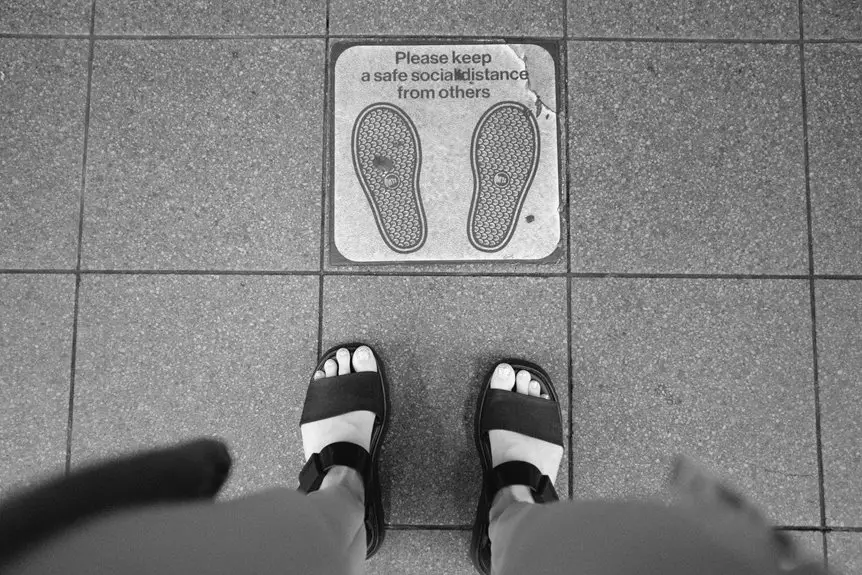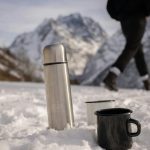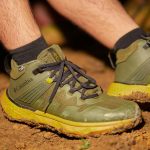You rely on Kevlar in shoes to deliver unmatched protection against cuts and punctures without adding bulk or weight. Originally used in bulletproof vests, Kevlar now reinforces work boots, hiking shoes, and athletic footwear, offering lightweight durability and impact resistance. It keeps your feet safe from sharp objects and harsh environments while maintaining comfort and flexibility. Discover how this innovation enhances safety and comfort, plus tips on care and exciting advances ahead.
Table of Contents
Key Takeaways
- Kevlar fibers enhance shoe durability by providing lightweight, cut, and puncture resistance for superior foot protection in hazardous environments.
- Kevlar is woven into shoe uppers or midsoles to resist sharp objects, improving safety without compromising mobility or comfort.
- Kevlar shoes are used in work boots, hiking, and athletic footwear for impact resistance, heat protection, and reduced injury risk.
- Compared to traditional safety shoes, Kevlar footwear offers lighter weight, greater flexibility, and better agility without sacrificing protection.
- Innovations in Kevlar technology include improved weaves, fiber blends, and smart materials for enhanced durability, breathability, and comfort in safety shoes.
What Is Kevlar and How Does It Work in Footwear?
Kevlar is a strong synthetic fiber known for its durability and resistance to impact. When used in footwear, it acts as a protective layer that shields your feet from sharp objects and abrasions without adding much weight.
You’ll find Kevlar woven into the shoe’s upper or embedded in the midsole, offering puncture resistance and enhanced toughness. This means your shoes can handle rough terrain or hazardous work environments while still feeling flexible and comfortable.
Because Kevlar fibers are incredibly tough yet lightweight, they keep your footwear durable without sacrificing mobility.
Historical Uses of Kevlar Beyond Bulletproof Vests
Although most people associate it with bulletproof vests, this remarkable fiber has played a role in a variety of applications over the decades.
You might be surprised to learn Kevlar has been used in racing tires, where its strength reduces punctures and improves durability.
It’s also found in aerospace, reinforcing aircraft components to withstand extreme stress while saving weight.
If you enjoy outdoor activities, Kevlar’s been woven into climbing ropes and protective gloves, giving you safety without sacrificing flexibility.
Even in sports, it’s used in helmets and protective gear to absorb impacts.
Understanding these historical uses helps you appreciate why Kevlar’s strength and resilience make it a natural choice for enhancing footwear safety today.
Key Benefits of Kevlar-Enhanced Shoes
When you wear Kevlar-enhanced shoes, you get superior cut resistance that keeps your feet safe in tough environments.
They also offer improved durability, so your shoes last longer under heavy use.
Plus, you won’t sacrifice comfort since Kevlar adds protection without extra weight.
Enhanced Cut Resistance
Because you often encounter sharp objects on the ground, having shoes that resist cuts can protect your feet from injuries.
Kevlar-enhanced shoes offer this essential protection by incorporating tightly woven Kevlar fibers into their design. These fibers create a strong barrier that prevents blades, glass shards, or nails from penetrating the sole or sides of your footwear.
This means you can walk confidently through hazardous environments without worrying about unexpected cuts. The enhanced cut resistance also reduces the risk of painful wounds and infections, keeping you safer throughout your day.
Whether you work in construction, landscaping, or simply navigate urban streets, Kevlar’s cut-resistant properties guarantee your feet stay guarded against sharp dangers you might encounter.
Improved Durability
If you want shoes that last longer and withstand tough conditions, Kevlar-enhanced footwear delivers unmatched durability.
Kevlar fibers are incredibly strong and resist wear and tear far better than traditional materials. When you wear shoes reinforced with Kevlar, you reduce the chances of rips, punctures, and abrasions ruining your footwear during demanding activities.
This means you won’t have to replace your shoes as often, saving you time and money. The material’s resilience also keeps your shoes looking and performing well, even after extensive use.
Whether you’re working in harsh environments or exploring rugged terrain, Kevlar’s durability guarantees your shoes maintain their protective qualities over the long haul, giving you reliable support every step of the way.
Lightweight Protective Comfort
Kevlar-enhanced shoes offer a unique combination of lightweight design and robust protection that you’ll appreciate every time you put them on.
You won’t feel weighed down, even during long hours on your feet, because Kevlar fibers provide strength without bulk. This means you can move quickly and comfortably without sacrificing safety.
The material’s flexibility adapts to your foot’s natural motion, reducing fatigue and enhancing comfort. Plus, Kevlar resists punctures and abrasions, so your feet stay protected from sharp objects and rough surfaces.
Whether you’re on a construction site or tackling outdoor adventures, these shoes give you reliable defense with a surprisingly light feel.
You get the best of both worlds—comfort and protection—without compromise.
Types of Shoes That Incorporate Kevlar Materials
You’ll find Kevlar in various types of shoes designed for protection and performance.
Work boots often use Kevlar to guard against sharp objects, while some athletic shoes incorporate it for added durability and support.
Let’s look at how these shoes benefit from Kevlar materials.
Work Boots With Kevlar
When you wear work boots with Kevlar, you get exceptional protection without sacrificing comfort.
These boots integrate Kevlar fibers in the upper layers or midsoles, making them resistant to cuts, punctures, and abrasions. If your job exposes you to sharp objects or rough terrain, Kevlar work boots shield your feet better than traditional materials.
They also tend to be lightweight, so you won’t feel weighed down during long shifts. Many models include steel or composite toes alongside Kevlar reinforcements for thorough safety.
Plus, Kevlar’s heat-resistant properties add an extra layer of defense in hazardous environments.
Whether you’re in construction, manufacturing, or outdoor labor, these boots help you stay safe while maintaining flexibility and durability throughout your workday.
Athletic Shoes Featuring Kevlar
Several types of athletic shoes now incorporate Kevlar to boost durability and protection without adding bulk. Whether you’re hitting the trail, training in the gym, or running on city streets, Kevlar-enhanced shoes provide extra strength and cut resistance where you need it most. You’ll appreciate how these shoes maintain flexibility and comfort while offering added safety from sharp objects or rough terrain.
| Shoe Type | Kevlar Benefit |
|---|---|
| Trail Running | Guards against rocks and roots |
| Cross Trainers | Protects from gym hazards |
| Road Runners | Strengthens sole for durability |
| Hiking Shoes | Adds cut resistance on rugged paths |
With Kevlar, you get shoes that keep up with your active lifestyle and protect every step you take.
How Kevlar Improves Safety in Industrial Footwear
Although industrial environments pose numerous hazards, Kevlar greatly boosts your footwear’s protective abilities.
When you wear Kevlar-reinforced shoes, you gain superior cut and puncture resistance, vital for handling sharp tools or stepping on debris. Kevlar’s lightweight yet incredibly strong fibers shield your feet without adding bulk, so you stay agile and comfortable during long shifts.
Its heat-resistant properties also protect you from hot surfaces or sparks, reducing burn risks. Additionally, Kevlar enhances impact resistance, helping to prevent injuries from heavy falling objects.
The Role of Kevlar in Outdoor and Hiking Shoes
Kevlar’s protective qualities don’t just benefit industrial footwear—they also play a significant role in outdoor and hiking shoes.
When you’re trekking through rough terrain, you need shoes that shield your feet from sharp rocks, thorny bushes, and unexpected scrapes. Kevlar’s high tensile strength lets your shoes resist punctures and abrasions without adding extra weight, keeping your steps light and secure.
You’ll also appreciate its durability; Kevlar fibers withstand wear and tear better than many traditional materials, so your shoes last longer on rugged trails.
Plus, Kevlar’s heat resistance helps protect your feet in hot conditions or when crossing warm surfaces.
Choosing hiking shoes with Kevlar means you’ll get reliable protection and comfort, helping you focus on the adventure ahead.
Comparing Kevlar Shoes to Traditional Safety Footwear
When you compare Kevlar shoes to traditional safety footwear, you’ll notice key differences in weight, flexibility, and protection.
Kevlar shoes are notably lighter, letting you move more freely without feeling weighed down by heavy steel toes or thick soles. You’ll also find that Kevlar’s woven fibers provide excellent cut and puncture resistance, often outperforming conventional materials in protecting your feet from sharp objects.
Unlike traditional safety boots, which can be rigid and bulky, Kevlar shoes offer enhanced flexibility, making them more practical for jobs requiring agility.
However, while Kevlar excels in certain protective qualities, traditional safety shoes often feature reinforced steel or composite toes that provide superior impact resistance.
Understanding these distinctions helps you choose the right footwear based on your specific safety needs.
Comfort and Durability: Balancing Protection and Wearability
When you choose Kevlar shoes, you get a unique blend of material flexibility and strength that keeps your feet protected without feeling stiff.
You’ll also appreciate how breathability and moisture control help you stay comfortable all day long.
Plus, these shoes are built for long-lasting wear resistance, so they hold up through tough conditions.
Material Flexibility and Strength
Although you want your shoes to provide strong protection, they must also flex and move with your feet. Kevlar’s unique fiber structure offers impressive strength without sacrificing flexibility, allowing your shoes to withstand impacts and abrasions while still bending naturally as you walk or run.
This balance means your footwear won’t feel stiff or restrictive, so you maintain comfort throughout the day. The material’s durability guarantees long-lasting wear, reducing the need for frequent replacements.
When manufacturers combine Kevlar with flexible components like elastomers or mesh, your shoes can absorb shocks and adapt to different movements seamlessly.
Ultimately, this blend of material flexibility and strength lets you stay protected without compromising agility or comfort in your daily activities.
Breathability and Moisture Control
Because your feet need to stay dry and cool, breathability and moisture control play an essential role in shoe comfort and durability.
Kevlar’s tight weave offers excellent protection, but it can trap heat and moisture if not combined with breathable materials. Manufacturers often integrate mesh panels or moisture-wicking linings alongside Kevlar to promote airflow and prevent sweat buildup.
This combination helps reduce odors and skin irritation, keeping your feet comfortable during long wear. You’ll appreciate shoes that balance Kevlar’s strength with ventilation features, allowing moisture to escape without sacrificing safety.
Long-Lasting Wear Resistance
While you want shoes that protect your feet, you also need them to stand up to daily wear and tear.
Kevlar’s exceptional strength offers long-lasting wear resistance, making your shoes more durable without adding bulk. This means your footwear can handle rough surfaces, abrasions, and impacts over time, saving you money on replacements. You won’t have to worry about scuffs or tears compromising the shoe’s integrity.
Plus, Kevlar maintains flexibility, so your shoes stay comfortable while resisting damage. By choosing Kevlar-reinforced shoes, you get a reliable balance between protection and durability.
You’ll enjoy footwear that not only guards your feet but also lasts through your toughest days, giving you confidence every step you take.
Innovations in Kevlar Weaving and Design for Shoes
When you look at the latest advancements in Kevlar weaving for shoes, you’ll see how designers have pushed the material’s limits to combine strength with flexibility. They’ve developed tighter weaves that enhance durability without sacrificing comfort. Innovations include blending Kevlar with other fibers to improve breathability and reduce weight. You’ll also find new weaving patterns that target impact zones for extra protection. These design tweaks make shoes safer and more comfortable for daily wear.
| Innovation Type | Benefit |
|---|---|
| Tightened Weave | Increased durability |
| Fiber Blending | Enhanced breathability |
| Impact-Zone Weaving | Targeted protection |
| Lightweight Designs | Reduced shoe weight |
| Flexible Patterns | Improved comfort and fit |
Care and Maintenance Tips for Kevlar-Infused Shoes
The innovations in Kevlar weaving not only boost your shoes’ performance but also influence how you should care for them.
To keep your Kevlar-infused shoes in top shape, avoid machine washing or drying, as this can damage the fibers. Instead, clean them gently with a soft brush or damp cloth to remove dirt and debris.
Let your shoes air dry away from direct heat sources to maintain the integrity of the Kevlar material. Store them in a cool, dry place to prevent moisture buildup that can weaken the fibers.
Regularly inspect your shoes for signs of wear or damage, especially around high-stress areas.
Future Trends in Kevlar Technology for Footwear Safety
As materials science advances, you’ll see Kevlar becoming even more integral to footwear safety. Future trends point to lighter, more flexible Kevlar fibers that won’t compromise protection.
You’ll also notice shoes incorporating Kevlar with smart materials, offering enhanced durability and real-time damage detection. Expect manufacturers to blend Kevlar with sustainable, eco-friendly components, addressing environmental concerns without sacrificing strength.
Additionally, customization will improve, letting you choose Kevlar placement based on your specific work or activity needs. Enhanced breathability and comfort will also be a focus, so you won’t have to trade safety for wearability.
Future Kevlar footwear will offer tailored protection and improved comfort, balancing safety with breathability seamlessly.
As these innovations emerge, your Kevlar-infused shoes won’t only protect better but also adapt to your lifestyle, making safety smarter and more seamless than ever before.
Frequently Asked Questions
Can Kevlar Shoes Be Recycled or Are They Environmentally Friendly?
You can’t easily recycle Kevlar shoes because the material is tough and complex. While they offer durability, they’re not very eco-friendly. You should consider their long life to reduce waste, but recycling options remain limited.
Are Kevlar Shoes Suitable for Casual Everyday Wear?
You can wear Kevlar shoes casually, but they might feel stiffer and less breathable than regular shoes. They’re tough and protective, so if comfort’s your priority, they might not be the best for everyday use.
How Do Kevlar Shoes Perform in Extreme Weather Conditions?
Like a shield against storms, Kevlar shoes keep you protected in extreme weather. They resist cuts, abrasions, and some water, but you might need extra insulation or waterproofing for freezing or soaking conditions.
What Is the Typical Price Range for Kevlar-Enhanced Footwear?
You’ll usually find Kevlar-enhanced footwear priced between $80 and $200, depending on the brand and features. Higher-end models with extra protection or specialized designs might cost even more, but you get solid durability for your money.
Are There Any Known Allergies or Sensitivities to Kevlar in Shoes?
You might experience skin irritation or allergies if you’re sensitive to aramid fibers like Kevlar. While rare, some people develop redness or itching, so it’s smart to test the material on a small skin area before prolonged use.
- How to Choose the Right Nonwoven Fabric for Your Application - July 11, 2025
- Nonwoven Fabrics in Agriculture: Crop Covers and Weed Barriers - July 11, 2025
- The Use of Nonwovens in Automotive Interiors - July 11, 2025







